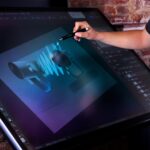In recent years, smart whiteboards have emerged as a game-changer in all levels of the education sector – from nursery and preschool to school and college. While there’s no doubt about their potential to transform classrooms into lively hubs for learning, choosing the right smart whiteboard for your teaching space can often be overwhelming.
At Speechi, we’ve equipped over 150,000 spaces (and counting!) with smart white boards – and with more classrooms embracing this innovative technology, the number continues to grow.
In this article, we’d like to share some of our expertise, and guide you in choosing the best smart whiteboard for your classroom. From preschool to primary school and college, we will guide you through the different considerations you should have for each use-case.
Choosing smart whiteboards for preschool classrooms

When choosing the right smart white board for your preschool classroom, the first factor that will drastically narrow down your purchase options will be size. Since preschoolers are small in stature, they won’t be able to reach across larger screens – so with this in mind, you’ll need to opt for a smart whiteboard model with a smaller screen dimension.
For this use-case, our 55” screens are perfect. 65” screens could also be suitable, but smaller-scale screen dimensions are more advisable to make them as easy as possible for preschoolers to use.
When it comes to sensors for the smart whiteboard screen, we’d recommend looking at infrared rather than capacitive technology. As a preschool teacher, you are unlikely to need the ultra-high precision offered by a capacitive screen, and infrared screens are also a more budget-friendly option.
Finally, height-adjustable screen supports are a must for smart whiteboards in preschool. By using one of these with your interactive screen, you can ensure that everyone – both teachers and preschoolers – can comfortably use the technology. Preschool teachers won’t have to stoop every time they interact with the screen, and can thus avoid issues with their posture and spine.
Choosing smart whiteboards for school
If you are looking to set up a smart whiteboard in a primary school setting, it’s worth noting that, similar to preschoolers, height may be an issue depending on the school-year you are teaching. For example, key-stage 1 students (years 1-2) will need a smart whiteboard that is slightly on the smaller side in order to reach every part of it.

For this, a 65” screen would be ideal. However, for key-stage 2 (years 3-6), height will no longer be as much of an issue, and most pupils on the older end of the scale should comfortably be able to use a 75” screen.
If you’re looking to set up your smart whiteboard in a secondary school, then the difference in height is mostly closed between students and teachers – so depending on your classroom’s dimensions, you can use a screen that is 75” or larger.
You will also no longer need to worry as much about height-adjustable supports, but it’s important to keep inclusivity and accessibility in mind. Do any of your students use wheelchairs? Are some of them particularly short in stature? If so, it may still be worth keeping your support height-adjustable.
Choosing smart white boards for college
If you’re setting up a smart white board in a college, your choice may become more nuanced. At this stage, you’re teaching young adults – and best smart whiteboard size will depend almost entirely on your classroom’s overall size and seating plan.

You’ll want to ensure that the display can be seen from the very back of the classroom, but not dwarf the entire space – and again, to make accommodations for students with physical disabilities, it’s worth choosing carefully between height-adjustable and fixed wall supports.
Finally, think about your use-case.
Are you teaching a subject that weighs heavily on attention to detail? For example, if you are teaching a course on fashion or architecture, you may want to opt for capacitive screen technology and a zero-bonding screen surface. This way, you can ensure ultra-high precision when you draw or sketch.
However, if your use-case falls outside of this category, infrared technology will be more than sufficient.





